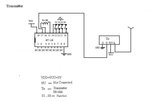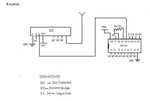speedEC
Full Member level 6
Dear All,
need a help to build simple wireless transmitter and receiver. I bought one wireless tx and rx (pair) and also HT12E and HT12D. I have connected all as per the circuit given at "roboticsy.blogspot.com". But I didn't get any result. Pl see the circuit design. I have used 1K in Transmitter and 56K in Receiver Circuit. I connected LED at pin 13 of HT12D (D0). The LED did not light-up. Also, I have connected LED at the pin 17 (VT) of HT12D thro' 2N3904 transistor. If the HT12D receive the valid signal, the VT pin goes high. If so, The connected LED should also light up. But, it also didn't.
Pl note:
1. I have used only one switch instead of 4 switches shown in circuit diagram of transistor.
2. I used 1/22 wire as antenna and their length is around 15cms each.
3. I have used Bread Board
4. I have placed both the transmitter and receiver in a same bread board
5. I left unconnected the pins 1-8 of HT12E and also HT12D.


Can anyone able to help me in this regard?
Advance thanks.
need a help to build simple wireless transmitter and receiver. I bought one wireless tx and rx (pair) and also HT12E and HT12D. I have connected all as per the circuit given at "roboticsy.blogspot.com". But I didn't get any result. Pl see the circuit design. I have used 1K in Transmitter and 56K in Receiver Circuit. I connected LED at pin 13 of HT12D (D0). The LED did not light-up. Also, I have connected LED at the pin 17 (VT) of HT12D thro' 2N3904 transistor. If the HT12D receive the valid signal, the VT pin goes high. If so, The connected LED should also light up. But, it also didn't.
Pl note:
1. I have used only one switch instead of 4 switches shown in circuit diagram of transistor.
2. I used 1/22 wire as antenna and their length is around 15cms each.
3. I have used Bread Board
4. I have placed both the transmitter and receiver in a same bread board
5. I left unconnected the pins 1-8 of HT12E and also HT12D.


Can anyone able to help me in this regard?
Advance thanks.